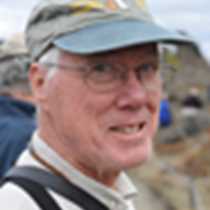The Falkland Islands
Geographically: two large (East and West Falkland) and myriad smaller islands located in the South Atlantic Ocean, 373 miles (600 km) east of South America and 870 miles (1,450 km) west of South Georgia Island. Geologically: an extension of the plains of Patagonia, made up of marine sediments and connected to South America by a continental shelf.
Historically: once an important port for repair and reprovisioning of ships beating their way around Cape Horn. Many of the sailing vessels can be found to this day on and under the water of Stanley Harbor. It is said that the Falklanders were quick to condemn a ship when they needed a supply of lumber! Later, the islanders were engaged in raising sheep for wool, but now that we are all wearing garments made of synthetics the wool market has vanished.
Biologically: the home of many wonderful and quite approachable species of birds like the Falkland Islands flightless steamer ducks seen here, the male with the brighter orange bill and feet in front, the female behind. They live here year-around, foraging in the kelp that surrounds the islands and covers the beaches. (Being outside of the Antarctic Convergence, the water around the Falkland Islands does not freeze.) As their name implies, flightless steamer ducks have abandoned flight altogether. In the absence of land predators, there is less need for flight than in their flying relatives. When disturbed, steamer ducks set off frantically over the surface of the water, feet paddling and wings flailing, making a great fuss and looking rather like a double side-wheeler under a full head of steam. And this is just one of the wonderful birds that we hope to see in our two days in the Falkland Islands.
Geographically: two large (East and West Falkland) and myriad smaller islands located in the South Atlantic Ocean, 373 miles (600 km) east of South America and 870 miles (1,450 km) west of South Georgia Island. Geologically: an extension of the plains of Patagonia, made up of marine sediments and connected to South America by a continental shelf.
Historically: once an important port for repair and reprovisioning of ships beating their way around Cape Horn. Many of the sailing vessels can be found to this day on and under the water of Stanley Harbor. It is said that the Falklanders were quick to condemn a ship when they needed a supply of lumber! Later, the islanders were engaged in raising sheep for wool, but now that we are all wearing garments made of synthetics the wool market has vanished.
Biologically: the home of many wonderful and quite approachable species of birds like the Falkland Islands flightless steamer ducks seen here, the male with the brighter orange bill and feet in front, the female behind. They live here year-around, foraging in the kelp that surrounds the islands and covers the beaches. (Being outside of the Antarctic Convergence, the water around the Falkland Islands does not freeze.) As their name implies, flightless steamer ducks have abandoned flight altogether. In the absence of land predators, there is less need for flight than in their flying relatives. When disturbed, steamer ducks set off frantically over the surface of the water, feet paddling and wings flailing, making a great fuss and looking rather like a double side-wheeler under a full head of steam. And this is just one of the wonderful birds that we hope to see in our two days in the Falkland Islands.




